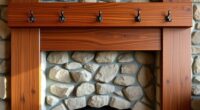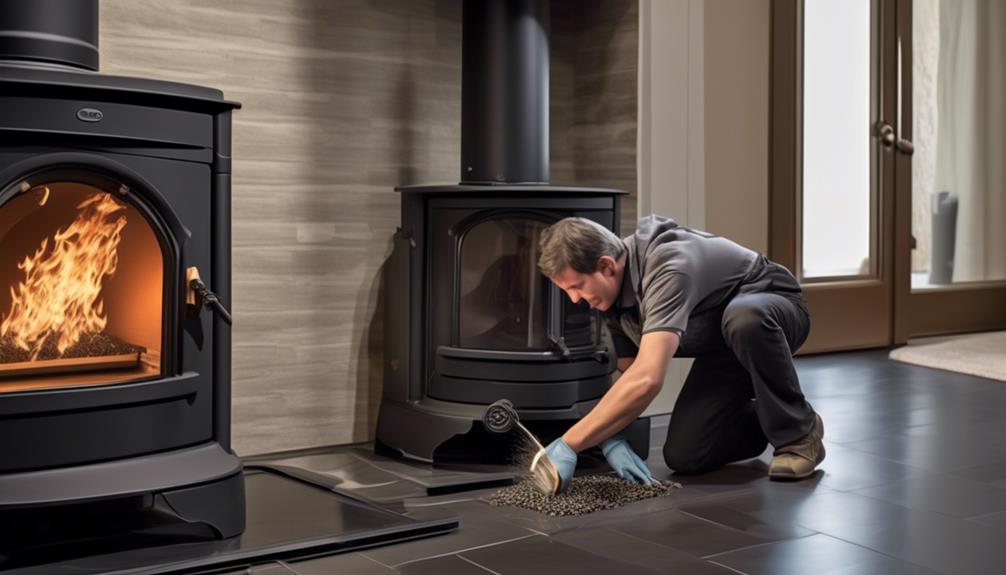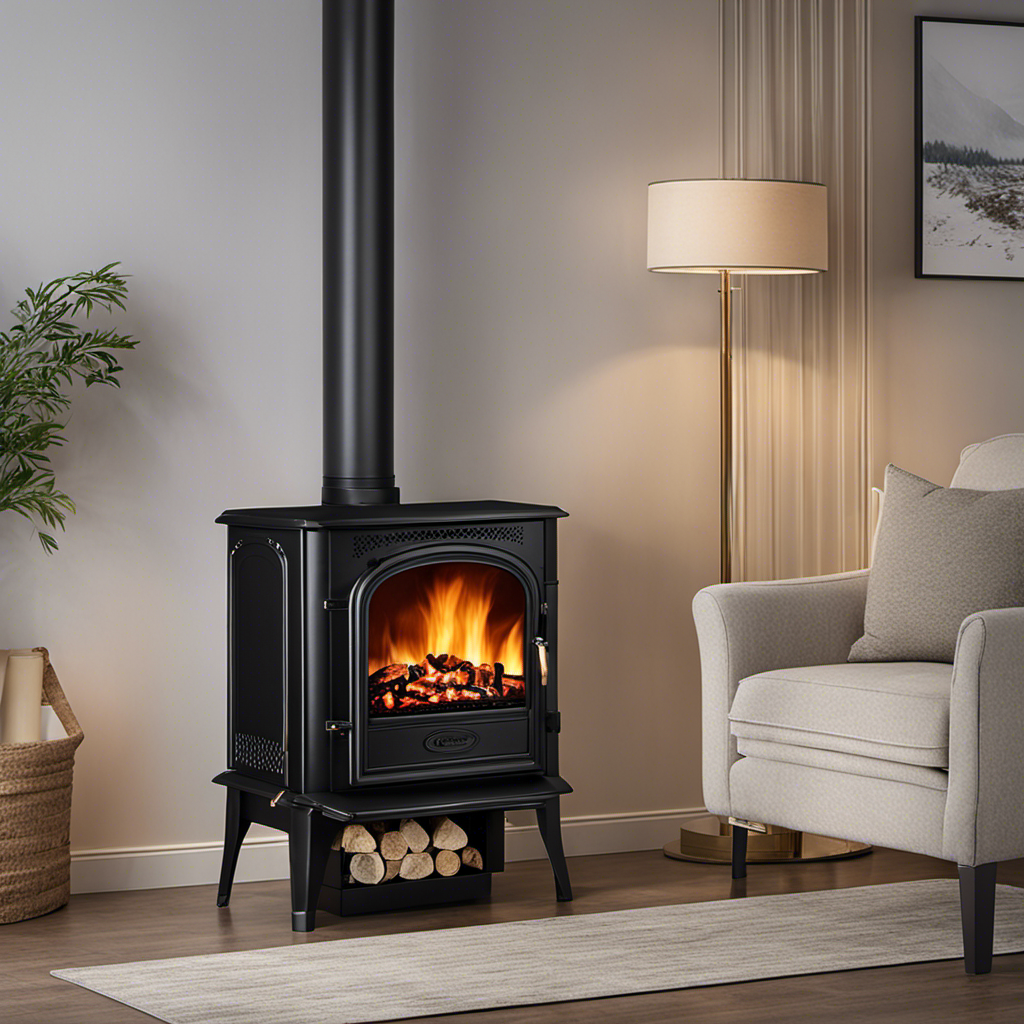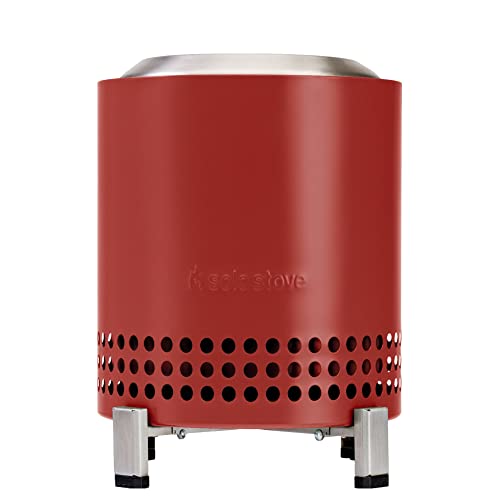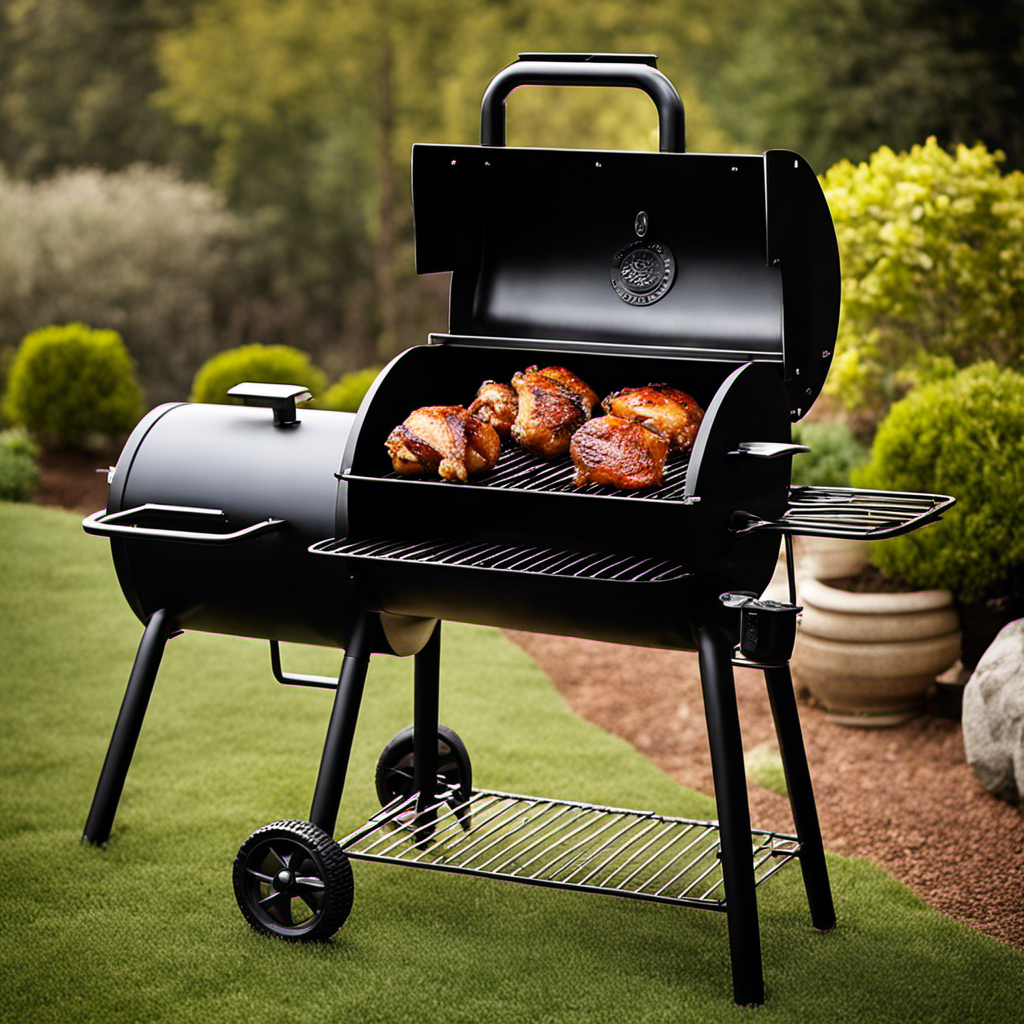Pellet stoves generate heat by automatically burning compressed wood or biomass pellets stored in a hopper, which feeds into a combustion chamber. The ignition system sparks to start the burn, then sensors and airflow control keep the flame steady. Heat is transferred through a heat exchanger, and ash is regularly removed to maintain efficiency. With proper maintenance and operation, you can enjoy clean, reliable warmth—stacked with expert tips to help you optimize performance every step of the way.
Key Takeaways
- Pellet stoves burn compressed wood/biomass pellets in a combustion chamber to generate heat efficiently and cleanly.
- They feature components like a hopper, auger, burn pot, heat exchanger, and ventilation system for optimal operation.
- Pellets are automatically fed from the hopper, ignited by a spark system, and maintained by sensors for consistent flames.
- Regular cleaning of the burn pot, ash removal system, and venting ensures safety, efficiency, and long lifespan.
- Proper airflow, high-quality pellets, and routine maintenance are essential for effective operation and energy efficiency.
How Pellet Stoves Generate Heat

Pellet stoves generate heat by burning compressed wood or biomass pellets in a controlled combustion chamber. The pellet fuel types vary, including hardwood, softwood, and blends, each offering different burn qualities and heat outputs. When you use these pellets, you’re also contemplating the environmental impact; many pellets are made from recycled wood waste, which reduces landfill waste and promotes sustainable forestry. The combustion process produces minimal ash and emissions, making pellet stoves a cleaner alternative to traditional fireplaces or wood stoves. As you operate the stove, pellets are fed automatically from a hopper, igniting to release consistent heat. This method not only ensures efficient heating but also supports eco-friendly energy use, aligning with greener living practices. Advancements in heat pump technology continue to improve efficiency and environmental benefits, and modern pellet stoves often incorporate automatic feeding systems to optimize performance and user convenience. Additionally, combustion efficiency improvements help reduce fuel consumption and emissions, further enhancing their sustainability. To maximize performance, regular cleaning and maintenance of the combustion chamber are essential to keep the stove functioning optimally.
Components of a Pellet Stove

Understanding how a pellet stove works involves knowing its key components. The fuel storage area holds the pellets, ensuring a steady supply as you operate the stove. The hopper feeds pellets into the burn pot, where combustion occurs. The ventilation system is vital; it directs airflow to support efficient burning and exhaust gases safely outside your home. Inside, you’ll find the combustion chamber, where heat is generated, and a heat exchanger that transfers warmth to your space. An electronic control system manages the stove’s functions, adjusting feed rates and airflow for superior performance. Additionally, proper maintenance of these components is essential for optimal fuel injection cleaning and overall stove efficiency. Regularly inspecting and cleaning the combustion chamber can help prevent buildup that reduces performance. Implementing cybersecurity measures can also protect your stove’s electronic controls from potential threats. Proper calibration and airflow management are crucial for maintaining consistent heat output. Together, these components work seamlessly to provide reliable, efficient heat with minimal effort on your part.
The Pellet Feeding Mechanism

Ever wonder how the stove guarantees a steady supply of pellets for continuous burning? It all comes down to the hopper design and the auger motor. The hopper holds the pellets and feeds them gradually into the burn chamber. Its design guarantees a consistent flow, preventing jams or shortages. The auger motor powers a rotating screw (auger) that moves pellets from the hopper to the burn pot. You can usually adjust the feed rate by changing the auger motor’s speed, giving you control over the burn rate. This precise mechanism ensures your stove maintains a steady fire without manual refilling constantly. Proper maintenance of the hopper and auger motor keeps the feeding process smooth, ensuring efficient operation and uninterrupted warmth. Understanding the feeding mechanism helps in troubleshooting and optimizing your stove’s performance. Regular inspection of the pellet flow can prevent blockages and ensure consistent heat output. Additionally, monitoring the hopper capacity can help prevent shortages during extended use. Being aware of the tuning techniques used in pellet stove components can further improve efficiency and longevity.
Ignition and Combustion Process

When you start your pellet stove, the ignition mechanism sparks to ignite the pellets. Once lit, the combustion cycle begins, involving steady air flow and heat production. Understanding these steps helps guarantee your stove runs efficiently and safely. Proper combustion efficiency is essential for optimal operation and energy savings. Additionally, regular maintenance ensures that the ignition process remains reliable and effective over time. Being aware of potential safety vulnerabilities can help prevent accidents and improve your stove’s longevity. Monitoring airflow regulation is also crucial for maintaining consistent combustion and preventing smoke buildup. Incorporating advanced automation technologies can further optimize stove performance and enhance user safety.
Ignition Mechanism Details
How does a pellet stove ignite and sustain combustion? The ignition system plays a key role, starting the process. When you turn on the stove, the ignition system activates, sending power to the spark plug. The spark plug creates a small, controlled spark that ignites the pellets in the burn pot. Once the pellets catch fire, the stove’s sensors detect the heat and maintain the flame. The ignition system then disengages, allowing the pellets to burn steadily. Proper maintenance of these components helps ensure reliable startup, ensuring quick ignition without manual lighting. After ignition, the stove’s control system adjusts airflow and pellet feed to sustain ideal combustion, providing consistent heat output. This precise process keeps your pellet stove operating efficiently and safely. Additionally, maintaining the proper cleaning and maintenance of the ignition components helps ensure reliable operation over time. Regularly inspecting and replacing worn parts can prevent ignition failure and extends the lifespan of your stove, ensuring it continues to function effectively.
Combustion Cycle Steps
After the ignition system sparks the pellets into flames, the combustion cycle begins. You want to guarantee proper ignition timing so the pellets ignite smoothly and efficiently. As the flame develops, the stove’s airflow sustains combustion, creating heat. During this process, ash slowly accumulates and must be regularly removed to maintain peak performance. The stove’s ash removal system helps keep the combustion chamber clear, preventing blockages that could hinder airflow or cause inefficient burning. Once ignition is complete, the stove shifts into steady-state combustion, maintaining consistent heat output. Monitoring ignition timing and ash buildup is essential for safe, efficient operation. Properly managing these steps ensures your pellet stove runs smoothly, providing reliable warmth while minimizing maintenance issues. Understanding the refrigeration cycle principles can aid in optimizing stove performance and troubleshooting any operational issues. Regular maintenance and understanding of the combustion cycle steps can extend the lifespan of your pellet stove and improve its efficiency. Additionally, maintaining proper airflow and fuel quality are crucial operating tips to ensure consistent and efficient heating. Ensuring the airflow system functions correctly helps sustain combustion and optimize heat output.
Controlling and Monitoring Your Stove

Controlling and monitoring your pellet stove effectively guarantees safe and efficient operation. Using features like a remote control and digital display, you can easily adjust settings and keep track of performance. The remote control allows you to change the temperature, fan speed, and operating mode from a distance, providing convenience. The digital display shows real-time data such as temperature, pellet level, and error messages, helping you stay informed. Regularly utilizing the detailed analytics can help you identify usage patterns and optimize your stove’s efficiency. Keep an eye on pellet levels and error codes to avoid unexpected shutdowns.
Maintenance and Troubleshooting Tips

Regular maintenance is essential to keep your pellet stove running safely and efficiently. Start by regularly cleaning the fuel storage area to prevent jams and ensure a steady supply of pellets. Check that pellets are dry and stored in a cool, dry place to avoid moisture that can cause ignition issues. Inspect the venting considerations to ensure there are no blockages or leaks, which can lead to dangerous fumes or inefficiency. Clean the burn pot and ash trap frequently to prevent buildup that hampers performance. Also, examine the exhaust pipe for obstructions or cracks, and make sure the seals are tight. Performing these routine checks helps avoid common problems and keeps your stove operating smoothly, saving you money and reducing safety risks.
Tips for Maximizing Efficiency and Safety

Maintaining your pellet stove’s cleanliness and inspecting its components regularly can considerably boost both safety and efficiency. Proper ventilation safety guarantees dangerous fumes don’t build up, so check vents and chimneys for blockages. Store fuel in a cool, dry place to prevent spoilage and fire hazards. To maximize performance, ensure your stove is loaded with high-quality pellets, and keep the burn pot clean. Additionally, regularly examine the auger and sensors for proper operation. Here are some tips to help you stay safe and efficient:
- Keep vents and exhaust pathways clear to ensure proper ventilation safety.
- Use well-maintained, dry fuel stored away from heat sources.
- Schedule routine inspections of electrical components and seals.
Following these steps helps your stove operate smoothly and safely.
Frequently Asked Questions
How Long Does a Bag of Pellets Typically Last?
A bag of pellets usually lasts about 24 to 48 hours, depending on your pellet storage, stove model, and how often you use it. To maximize fuel efficiency, keep your pellets dry and stored properly. Using the stove consistently at moderate settings helps conserve pellets, making each bag go further. Regular maintenance and proper storage guarantee you get the most out of your pellets and keep your heating efficient.
Can Pellet Stoves Be Used During Power Outages?
Did you know pellet stoves can keep your home warm during power outages? While they usually rely on electricity, some models have battery backups or manual ignitions, making them viable alternative fuel sources. You should always follow safety precautions, like proper ventilation and avoiding combustible materials nearby. With the right setup, you can enjoy reliable heat even when the power’s out, making pellet stoves a smart backup option.
Are Pellet Stoves Environmentally Friendly?
You might wonder if pellet stoves are environmentally friendly. They’re a great choice for sustainable heating because they burn compressed wood pellets, which are made from renewable resources. This process helps reduce emissions compared to traditional wood burning or fossil fuels. Plus, pellet stoves produce fewer pollutants, supporting emission reduction efforts. Overall, they’re a cleaner, more eco-conscious way to heat your home while minimizing your carbon footprint.
What Is the Average Lifespan of a Pellet Stove?
Ever wonder how long your pellet stove will last? On average, with proper maintenance schedules and quality fuel types, you can expect it to serve you 15 to 20 years. Regular cleaning and timely part checks are key to longevity. Neglecting these can shorten its lifespan, but with diligent care, your stove can keep heating your home efficiently for many years to come.
Do Pellet Stoves Require Professional Installation?
You might wonder if pellet stoves need professional installation. Generally, yes, because installation requirements include proper venting and clearance, which assure safety and efficiency. Hiring a professional helps you meet local codes and minimizes maintenance considerations later on. Proper setup guarantees your stove runs smoothly and lasts longer, giving you peace of mind. Attempting a DIY install could lead to issues, so it’s best to rely on experts for a safe, effective setup.
Conclusion
Now that you know how pellet stoves work, you’re better equipped to operate and maintain yours safely. Regular maintenance can boost efficiency by up to 15%, saving you money and reducing emissions. Keep an eye on your stove’s performance, follow safety tips, and don’t hesitate to troubleshoot issues early. With proper care, your pellet stove can provide reliable, eco-friendly warmth for years to come, making it a smart choice for cozy, sustainable heating.


